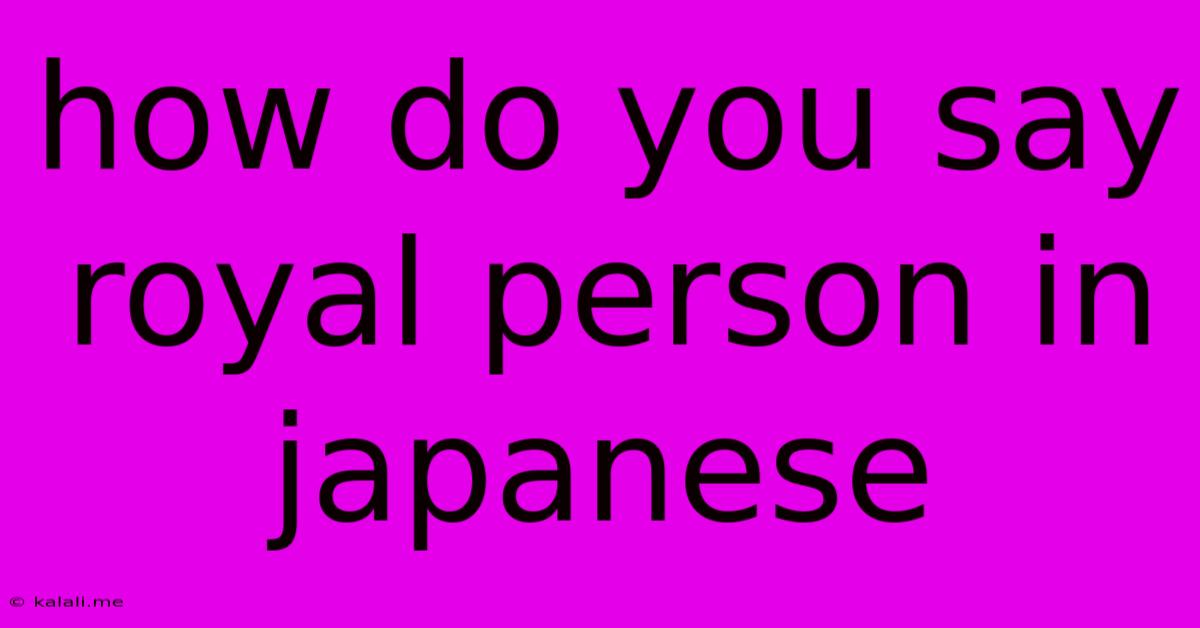How Do You Say Royal Person In Japanese
Kalali
Jun 08, 2025 · 2 min read

Table of Contents
How Do You Say "Royal Person" in Japanese? A Comprehensive Guide
This article explores the nuanced ways to refer to royalty in Japanese, delving beyond simple translations to provide a deeper understanding of the cultural context surrounding these terms. Understanding these nuances is crucial for accurate and respectful communication, whether you're writing a historical fiction novel, translating documents, or simply expanding your knowledge of Japanese culture.
Meta Description: Learn how to correctly refer to royal persons in Japanese. This comprehensive guide explores various terms, their nuances, and cultural contexts, offering a deeper understanding beyond simple translations.
The Primary Terms: 皇室 (kōshitsu) and 王室 (ōshitsu)
While a direct translation of "royal person" doesn't perfectly capture the Japanese understanding of royalty, the most common starting points are:
-
皇室 (kōshitsu): This term refers to the Imperial Family, the reigning royal family of Japan. It literally translates to "Imperial Household" or "Imperial Family." Using this term is appropriate when referring to the Emperor, Empress, Crown Prince, and other members of the direct imperial lineage.
-
王室 (ōshitsu): This term refers to a royal family in general, often used in contexts referencing other countries' monarchies. It translates to "royal family" or "kingdom." You might use this when discussing the British Royal Family or other European monarchies.
Addressing Royal Individuals: Titles and Honorifics
Addressing royal individuals requires careful attention to proper titles and honorifics. Here are some key examples:
- 天皇 (tennō): Emperor
- 皇后 (kōgō): Empress
- 皇太子 (kōtaishi): Crown Prince
- 皇太子妃 (kōtaishihi): Crown Princess
- 陛下 (heika): Your Majesty (a highly formal address used for the Emperor and Empress)
Note that using the correct title is paramount. Incorrect or informal addressing is considered extremely disrespectful in Japanese culture.
Beyond the Basics: Context and Nuance
The choice of terminology extends beyond simple titles. The context in which you use these words is also vital.
-
Formal vs. Informal Language: Formal language (丁寧語 - teineigo) is always required when discussing members of the Imperial Family. Informal language is unacceptable.
-
Historical Context: When discussing historical figures, the appropriate titles and terms may differ depending on the era.
Examples in Sentences
- 日本の皇室は長い歴史を持っています。(Nihon no kōshitsu wa nagai rekishi o motteimasu.) - The Imperial Family of Japan has a long history.
- イギリスの王室についての記事を読みました。(Igirisu no ōshitsu ni tsuite no kiiji o yomimashita.) - I read an article about the British royal family.
- 天皇陛下万歳!(Tennō Heika banzai!) - Ten thousand years to His Majesty the Emperor! (A celebratory shout)
Conclusion: Respect and Accuracy
Referring to royal persons in Japanese demands both accuracy and respect. Understanding the difference between 皇室 (kōshitsu) and 王室 (ōshitsu), employing correct titles and honorifics, and considering the context are all crucial for communicating effectively and appropriately. This detailed guide provides a solid foundation for respectful and accurate communication regarding Japanese and international royalty. Remember to always prioritize politeness and formality when discussing members of the imperial family or other royal figures.
Latest Posts
Latest Posts
-
Mac Is Not In The Sudoers File
Jun 08, 2025
-
How To Get Pen Ink Off Skin
Jun 08, 2025
-
Can You Walk Over Covered In Ground Swimming Ools
Jun 08, 2025
-
Witcher 3 Console Commands Skip Quest
Jun 08, 2025
-
How Long To Let Bread Cool Before Cutting
Jun 08, 2025
Related Post
Thank you for visiting our website which covers about How Do You Say Royal Person In Japanese . We hope the information provided has been useful to you. Feel free to contact us if you have any questions or need further assistance. See you next time and don't miss to bookmark.